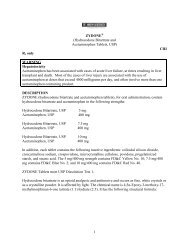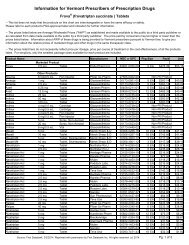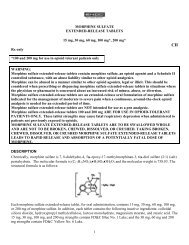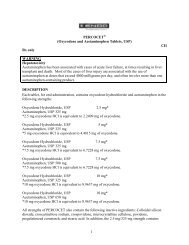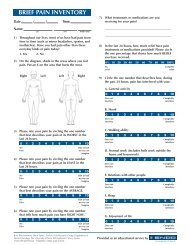F A C T S H E E T - Endo Pharmaceuticals
F A C T S H E E T - Endo Pharmaceuticals
F A C T S H E E T - Endo Pharmaceuticals
Create successful ePaper yourself
Turn your PDF publications into a flip-book with our unique Google optimized e-Paper software.
F A C T S H E E T<br />
<strong>Endo</strong>cet ® Tablets (Oxycodone and<br />
Acetaminophen Tablets, USP) 7.5 mg/325 mg<br />
<strong>Endo</strong>cet ® Tablets (Oxycodone and<br />
Acetaminophen Tablets, USP) 10 mg/325 mg<br />
Generic equivalent to Percocet ® 7.5 mg/325 mg Tablets and Percocet ® 10 mg/325 mg Tablets<br />
<strong>Endo</strong>cet ® 7.5 mg/325 mg Tablets and <strong>Endo</strong>cet ® 10 mg/325 mg Tablets<br />
Item # 60951-<br />
Product<br />
Description Count Color/ID<br />
0700-70 7.5 mg/325 mg Tablets 100 PEACH CAPSULE-SHAPED TABLET WITH E 700<br />
ON ONE SIDE AND 7.5/325 ON THE OTHER.<br />
0712-70 10 mg/325 mg Tablets 100 YELLOW OVAL TABLET WITH E 712<br />
ON ONE SIDE AND 10/325 ON THE OTHER.<br />
Bottle Size Volume Weight Height Length Depth<br />
0700-70 100 Tablets 19.44 cu. in. 0.11 lbs. 4.06” N.A. 2.19”<br />
0712-70 100 Tablets 19.44 cu. in. 0.11 lbs. 4.06” N.A. 2.19”<br />
Inner Pack Count Volume Weight Height Length Depth<br />
0700-70 6 129.97cu. in. 0.66 lbs. 4.06” 7.31” 4.38”<br />
0712-70 6 129.97cu. in. 0.66 lbs. 4.06” 7.31” 4.38”<br />
Case Pack Count Volume Weight Height Length Depth<br />
0700-70 48 0.69 cu. ft. 6.25 lbs. 8.63” 14.94” 9.31”<br />
0712-70 48 0.69 cu. ft. 6.25 lbs. 8.63” 14.94” 9.31”<br />
The most frequently reported adverse reactions are lightheadedness, dizziness, sedation, nausea, vomiting,<br />
and constipation. Oxycodone can produce drug dependence and has the potential for being abused.<br />
<strong>Endo</strong>cet® is a registered trademark of <strong>Endo</strong> <strong>Pharmaceuticals</strong> Inc.<br />
Percocet® is a registered trademark of <strong>Endo</strong> <strong>Pharmaceuticals</strong> Inc.<br />
Please see Brief Summary information on following page.<br />
w w w . E n d o . c o m<br />
1 - 8 0 0 - 4 6 2 - E N D O<br />
C h a d d s F o r d , P A 1 9 3 1 7<br />
ECT-1006/JAN 2005<br />
©2005 <strong>Endo</strong> <strong>Pharmaceuticals</strong> Inc.
®<br />
®<br />
ENDO GENERIC PRODUCTS<br />
ENDOCET ®<br />
(Oxycodone and Acetaminophen Tablets, USP)<br />
5 mg/325 mg, 7.5 mg/325 mg, 7.5 mg/500 mg,<br />
10 mg/325 mg and 10 mg/650 mg<br />
Brief Summary (For full Prescribing Information and Patient Information, refer<br />
to package insert.)<br />
INDICATIONS AND USAGE<br />
ENDOCET is indicated for the relief of moderate to moderately severe pain.<br />
CONTRAINDICATIONS<br />
ENDOCET should not be administered to patients who are hypersensitive to<br />
oxycodone, acetaminophen, or any other components of this product.<br />
WARNINGS<br />
Drug Dependence<br />
Oxycodone can produce drug dependence of the morphine type and, therefore,<br />
has the potential for being abused. Psychic dependence, physical dependence<br />
and tolerance may develop upon repeated administration of ENDOCET, and it<br />
should be prescribed and administered with the same degree of caution<br />
appropriate to the use of other oral opioid-containing medications. Like other<br />
opioid-containing medications, ENDOCET is subject to the Federal Controlled<br />
Substances Act (Schedule II).<br />
PRECAUTIONS<br />
General<br />
Head Injury and Increased Intracranial Pressure: The respiratory depressant<br />
effects of opioids and their capacity to elevate cerebrospinal fluid pressure may<br />
be markedly exaggerated in the presence of head injury, other intracranial<br />
lesions or a pre-existing increase in intracranial pressure. Furthermore, opioids<br />
produce adverse reactions which may obscure the clinical course of patients<br />
with head injuries.<br />
Acute Abdominal Conditions: The administration of ENDOCET or other<br />
opioids may obscure the diagnosis or clinical course in patients with acute<br />
abdominal conditions.<br />
Special Risk Patients: ENDOCET should be given with caution to certain<br />
patients such as the elderly or debilitated, and those with severe impairment of<br />
hepatic or renal function, hypothyroidism, Addison's disease, and prostatic<br />
hypertrophy or urethral stricture.<br />
Information for Patients<br />
Oxycodone may impair the mental and/or physical abilities required for the<br />
performance of potentially hazardous tasks such as driving a car or operating<br />
machinery. The patient using ENDOCET should be cautioned accordingly.<br />
Drug Interactions<br />
Patients receiving other opioid analgesics, general anesthetics, phenothiazines,<br />
other tranquilizers, sedative-hypnotics or other CNS depressants (including<br />
alcohol) concomitantly with ENDOCET may exhibit an additive CNS depression.<br />
When such combined therapy is contemplated, the dose of one or both agents<br />
should be reduced.<br />
The concurrent use of anticholinergics with opioids may produce paralytic ileus.<br />
Usage in Pregnancy<br />
Teratogenic Effects; Pregnancy Category C: Animal reproductive studies<br />
have not been conducted with ENDOCET. It is also not known whether<br />
ENDOCET can cause fetal harm when administered to a pregnant woman or<br />
can affect reproductive capacity. ENDOCET should not be given to a pregnant<br />
woman unless in the judgment of the physician, the potential benefits outweigh<br />
the possible hazards.<br />
Nonteratogenic Effects: Use of opioids during pregnancy may produce<br />
physical dependence in the neonate.<br />
Labor and Delivery<br />
As with all opioids, administration of ENDOCET to the mother shortly before<br />
delivery may result in some degree of respiratory depression in the newborn<br />
and the mother, especially if higher doses are used.<br />
Nursing Mothers<br />
It is not known whether ENDOCET (Oxycodone and Acetaminophen Tablets,<br />
USP) is excreted in human milk. Because many drugs are excreted in human<br />
milk, caution should be exercised when ENDOCET is administered to a nursing<br />
woman.<br />
Pediatric Use<br />
Safety and effectiveness in pediatric patients have not been established.<br />
ADVERSE REACTIONS<br />
The most frequently observed adverse reactions include lightheadedness,<br />
dizziness, sedation, nausea and vomiting. These effects seem to be more<br />
prominent in ambulatory than in nonambulatory patients, and some of these<br />
adverse reactions may be alleviated if the patient lies down.<br />
Other adverse reactions include euphoria, dysphoria, constipation, skin rash and<br />
pruritus. At higher doses, oxycodone has most of the disadvantages of<br />
morphine including respiratory depression.<br />
DRUG ABUSE AND DEPENDENCE<br />
ENDOCET (Oxycodone and Acetaminophen Tablets, USP) is a Schedule II<br />
controlled substance.<br />
Oxycodone can produce drug dependence and has the potential for being<br />
abused (See WARNINGS).<br />
OVERDOSAGE<br />
Acetaminophen<br />
Signs and Symptoms: In acute acetaminophen overdosage, dose-dependent,<br />
potentially fatal hepatic necrosis is the most serious adverse effect. Renal<br />
tubular necrosis, hypoglycemic coma and thrombocytopenia may also occur.<br />
In adults, hepatic toxicity has rarely been reported with acute overdoses of less<br />
than 10 grams and fatalities with less than 15 grams. Importantly, young<br />
children seem to be more resistant than adults to the hepatotoxic effect of an<br />
acetaminophen overdose. Despite this, the measures outlined below should be<br />
initiated in any adult or child suspected of having ingested an acetaminophen<br />
overdose.<br />
Early symptoms following a potentially hepatotoxic overdose may include:<br />
nausea, vomiting, diaphoresis and general malaise. Clinical and laboratory<br />
evidence of hepatic toxicity may not be apparent until 48 to 72 hours postingestion.<br />
Treatment: The stomach should be emptied promptly by lavage or by induction<br />
of emesis with syrup of ipecac. Patient's estimates of the quantity of a drug<br />
ingested are notoriously unreliable. Therefore, if an acetaminophen overdose is<br />
suspected, a serum acetaminophen assay should be obtained as early as<br />
possible, but no sooner than four hours following ingestion. Liver function<br />
studies should be obtained initially and repeated at 24-hour intervals.<br />
The antidote, N-acetylcysteine, should be administered as early as possible,<br />
preferably within 16 hours of the overdose ingestion for optimal results, but in<br />
any case, within 24 hours. Following recovery, there are no residual, structural,<br />
or functional hepatic abnormalities.<br />
Oxycodone<br />
Signs and Symptoms: Serious overdosage with oxycodone is characterized<br />
by respiratory depression (a decrease in respiratory rate and/or tidal volume,<br />
Cheyne-Stokes respiration, cyanosis), extreme somnolence progressing to<br />
stupor or coma, skeletal muscle flaccidity, cold and clammy skin, and sometimes<br />
bradycardia and hypotension. In severe overdosage, apnea, circulatory<br />
collapse, cardiac arrest and death may occur.<br />
Treatment: Primary attention should be given to the reestablishment of<br />
adequate respiratory exchange through provision of a patent airway and the<br />
institution of assisted or controlled ventilation. The opioid antagonist naloxone<br />
hydrochloride is a specific antidote against respiratory depression which may<br />
result from overdosage or unusual sensitivity to opioids, including oxycodone.<br />
Therefore, an appropriate dose of naloxone hydrochloride (usual initial adult<br />
dose 0.4 mg to 2 mg) should be administered preferably by the intravenous<br />
route, and simultaneously with efforts at respiratory resuscitation (see package<br />
insert). Since the duration of action of oxycodone may exceed that of the<br />
antagonist, the patient should be kept under continued surveillance and<br />
repeated doses of the antagonist should be administered as needed to maintain<br />
adequate respiration.<br />
An antagonist should not be administered in the absence of clinically significant<br />
respiratory or cardiovascular depression. Oxygen, intravenous fluids,<br />
vasopressors and other supportive measures should be employed as indicated.<br />
Gastric emptying may be useful in removing unabsorbed drug.<br />
DOSAGE AND ADMINISTRATION<br />
Dosage should be adjusted according to the severity of the pain and the<br />
response of the patient. It may occasionally be necessary to exceed the usual<br />
dosage recommended below in cases of more severe pain or in those patients<br />
who have become tolerant to the analgesic effect of opioids. ENDOCET is given<br />
orally. The usual adult dosage is one tablet every 6 hours as needed for pain.<br />
The total daily dose of acetaminophen should not exceed 4 grams.<br />
Strength<br />
ENDOCET 5 mg/325 mg<br />
ENDOCET 7.5 mg/325 mg<br />
ENDOCET 7.5 mg/500 mg<br />
ENDOCET 10 mg/325 mg<br />
ENDOCET 10 mg/650 mg<br />
Maximal Daily Dose<br />
12 Tablets<br />
8 Tablets<br />
8 Tablets<br />
6 Tablets<br />
6 Tablets<br />
Store at 20° to 25°C (68° to 77°F). [See USP Controlled Room Temperature.]<br />
Dispense in a tight, light-resistant container as defined in the USP, with a childresistant<br />
closure (as required).<br />
DEA Order Form Required.<br />
Manufactured for:<br />
<strong>Endo</strong> <strong>Pharmaceuticals</strong> Inc.<br />
Chadds Ford, Pennsylvania 19317<br />
ENDOCET ® is a Registered Trademark of <strong>Endo</strong> <strong>Pharmaceuticals</strong> Inc.<br />
Copyright © <strong>Endo</strong> <strong>Pharmaceuticals</strong> Inc. 2004<br />
Printed in U.S.A. Rev. October, 2004<br />
415142/415342 E1



